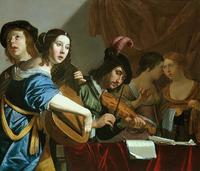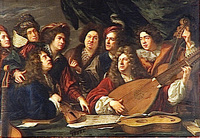- concept
- English
-
-
The theorbo is a plucked string instrument of the lute family, with an extended neck and a second pegbox. Like a lute, a theorbo has a curved-back sound box (a hollow box) with a wooden top, typically with a sound hole, and a neck extending out from the soundbox. As with the lute, the player plucks or strums the strings with one hand while "fretting" (pressing down) the strings with the other hand; pressing the strings in different places on the neck produces different pitches (notes), thus enabling the performer to play chords, basslines and melodies.
It is related to the liuto attiorbato, the French théorbe des pièces, the archlute, the German baroque lute, and the angélique or angelica. A theorbo differs from a regular lute in that the theorbo has a much longer neck which extends beyond the regular fingerboard/neck and a second pegbox at the end of the extended neck. Low-register bass strings are added on the extended neck. This gives a theorbo a much wider range of pitches (notes) than a regular lute. The theorbo was used during the Baroque music era (1600–1750) to play basso continuo accompaniment parts (as part of the basso continuo group, which often included harpsichord, pipe organ and bass instruments), and also as a solo instrument.
⟶ wikipedia
-
-
- sh85134711 ⟶ Theorbo
-
- Q840920 ⟶ Click Here
Theorbo
Theorbo
Θεόρβη (greek) | Theorbe (German)
Works belonging to this subject category




